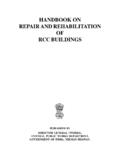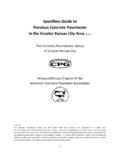Transcription of BioswaleCare - Welcome to NYC.gov
1 BioswaleCare HandbookWhat s Inside:What is a Right Of Way Bioswale?How does a Right Of Way Bioswale Work?The 5 Categories of Care What to PaletteList of Key OffendersWhy is the City building Right Of Way Bioswales? GREEN INFRASTRUCTURE RIGHT OF WAY BIOSWALEM ichael R. Bloomberg, MayorCarter H. Strickland, Jr. ComissionerWhat is a ROW Bioswale?Right of Way (ROW) Bioswales look a lot like street tree beds you see around New York City. If you look carefully, though, you ll notice that ROW Bioswales are significantly different from typical flower beds at the base of street trees. These differences are important because they ensure that the ROW Bioswales will be able to collect stormwater flowing down the streets and sidewalk when it rains.
2 How does a ROW Bioswale Work? ROW Bioswales aren t located just anywhere along the sidewalk. Instead, they are often built very close to catch basins. ROW Bioswales are primarily constructed just upstream of the catch basins so that by design they can partially collect the stormwater flowing down the street and sidewalk before it goes into the catch basin and ends up in the sewer system. By partially catching stormwater in the ROW Bioswale first, this water is used as a resource to help trees and plants grow, rather than going into an overwhelmed sewer are different standard sizes for ROW Bioswale beds and they are usually filled with one tree and different types of plants and shrubs. The tree and plants are carefully chosen so they can survive on a busy New York City street and absorb a lot of stormwater.
3 These plants also don t mind when stormwater stands for a short time in the slight depression at the center of the ROW Bioswale. 1)2)~1~What s a Catch Basin? You may not have heard the term catch basin before, but you ve seen one almost every time you cross the street in New York City! A catch basin is a type of drain structure, located next to the curb that collects all stormwater that falls on the street. There are more than 144,000 catch basins in the City of New York! This system of catch basins is designed to alleviate street flooding and efficiently capture the stormwater that falls on the street and discharge it into the sewer system. The Right-of-Way, or ROW, is the distance between property lines on either side of the street and encompasses the two sidewalks, parking lanes, and paved word Bioswale is generally used to describe planted areas that collects New York City Department of Environmental Protection (DEP) uses the term ROW Bioswale to describe planted areas in the sidewalk that are designed to collect and manage stormwater, or rainwater, that runs off the streets and sidewalks.
4 Each ROW Bioswale has a short metal fence, known as a tree guard, that goes along three sides of the planting bed. These tree guards are not just for decoration, they also protect the ROW Bioswale from people (and dogs!) that may accidently walk inside of the bed and damage the plants. ROW Bioswales also have an inlet and an outlet which are openings - or curb-cuts - in the curb. You can tell which one is the inlet because it is the curb-cut that is farthest away from the catch basin. When it rains this inlet lets the water flowing down the street into the ROW Bioswale. The outlet is the curb-cut closest to the catch basin. If there is a very intense rainstorm, or if it rains for a long time, the ROW Bioswale may fill to its capacity.
5 At those times, the outlet lets excess water flow out of the ROW Bioswale so that it can flow into the catch basin the way it normally would. ROW Bioswales also have a one-foot wide strip of small stones along the curb to protect the plants from car doors that are opening. 3)4)5)Photo: Inlet and outlet of a Bioswale~2~InletOutletWhat you can t see Beneath the ground each ROW Bioswale is almost five feet deep. The layers underneath the ROW Bioswale include sandy soils and stones that store stormwater and allow it to seep into the ground gradually. This process is called infiltration. The tree and plants also absorb the stormwater and release it from their leaves into the air as water vapor.
6 This process is called evapotranspiration. Each ROW Bioswale can collect an average of 2,244 gallons of water per rain storm! That s about 45 bathtubs worth of water! Caption: Images explaining all of the layers beneath the ground. You can see sandy soil ( engineered soil ), geotextile fabric, ( drainage fabric ) and stone layers. All of these layers are necessary for the ROW Bioswale absorb water that has been collected from the 5 Categories of CareTools you can use: Gardening gloves Hand tools for digging and weeding, such as a fork or trowel Bucket/hose Trash bag1. Communicate PURPOSE Most people do not know the difference between a ROW Bioswale and a regular street tree pit.
7 HOW TO Tell your friends and neighbors about ROW Bioswales, and explain what they are and how they work. Plus, the more people know about ROW Bioswales, the better they will treat yours! Make sure to check out your ROW Bioswale during a rainstorm so that you can see how it works. You may even want to take photos or videos. 2. Clean Out Litter PURPOSEU nfortunately, ROW Bioswales can quickly become filled with debris and litter. Garbage can be washed in from the street, blown in from the wind, or thrown in by people. This trash is harmful because it clogs the inlets and outlets and prevents the ROW Bioswale from collecting water properly. HOW TOClear litter from your ROW Bioswale often.
8 Remove any food scraps, dead plants, and animal waste because it can hurt the plants and attract pests. Make sure all trash has been removed from:- The inlets and outlets. This is how water comes and goes from the ROW Bioswale so make sure they aren t clogged by debris and sediment. - In and around the tree guard. The ROW Bioswale is designed to take in stormwater from the sidewalk as well and cannot function properly if there is litter blocking the tree guard. - In and around the stone strip. Photo: Litter in a Bioswale~3~3. Inspect the Soil and Plants PURPOSEThe soil and plants are specifically chosen to help the ROW Bioswale manage stormwater.
9 They should be inspected to make sure they are working the way they are supposed to. HOW TOImportant things to look for:- Soil erosion (areas where the soil has washed away) the special soil in your ROW Bioswale is designed to absorb water quickly and is placed in the ROW Bioswale in a very specific way that creates a channel to direct the flow of water. Heavy rain fall events cause the top soil and mulch to get washed away, clog the channel, and expose the roots of your plants. Make sure to inspect your ROW Bioswale for those types of signs of soil erosion after a storm. People and animals walking or running in your ROW Bioswale may also cause soil erosion.
10 If you can see the roots of the plants, or you see sand, debris or excess soil that has filled up the channel or buried the plants below, you should call 311. (More info is the Resources section.) - Vegetative health without thick healthy plants, the ROW Bioswale will not function properly. Make sure the plants of your Bioswale are healthy and dense. 4. Weed Often PURPOSEW eeding your ROW Bioswale is important to keep the plants healthy. Weeds are not only unsightly but they crowd the plants, making it hard for them to absorb water and grow strong. HOW TOIdentify the plants that were planted in your ROW Bioswale and pull out any foreign plants you see growing around them.


















